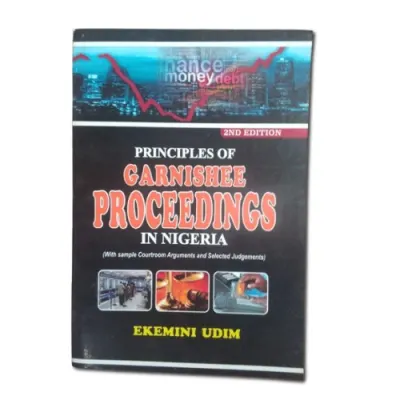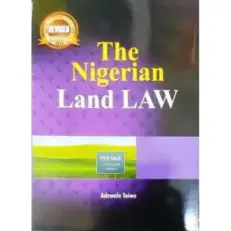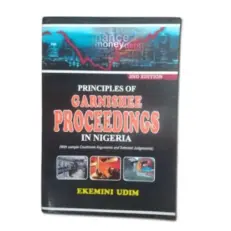Description
Principles Of Garnishee Proceedings In Nigeria By Ekemini Udim – 2nd Edition – 2015 Paperback
Have you ever secured a money judgment against a person or body and he/she/it refuses to pay? There are legal options you can explore to get your money. Options like Fieri Facias (fi.fa.), attachment of assets (moveable or immovable), imprisonment, garnishee proceedings etc.
Below is a brief description of the garnishee proceedings as curled from “Principles of Garnishee Proceedings in Nigeria”. A book written by Ekemini Udim esq.
” In our day-to-day interactions with fellow humans and corporate entities, debts are daily incurred. It is either a government is indebted to a contractor who has successfully executed some contracts for the government or the contractor is himself indebted to his workers. The banks could also be indebted to their external solicitors who have successfully completed authorized searches, litigations and perfection of instruments for the bank. A business partner could also be indebted to a fellow partner. A successful litigant may also be owed the judgment sum by the judgment debtor. The list is endless and can only be better imagined.
In most cases, it is the practice for the party that is owed to approach the debtor for payment of debt. This could be in the form of verbal or written solicitations. Where this fails, the legal option open to the creditor is for him to approach a court of law for an order directing the debtor to pay up his debt. This could be by way of undefended list procedure or writ of summons or any other applicable originating process. Where the creditor successfully pushes his way through and obtains an order of court directing the debtor to pay up his debt, the next hurdle for the judgment creditor is how to enforce the order of court and have his debt paid. This is where garnishee proceedings become the most suitable legal machinery through which a judgment creditor can successfully obtain his money from his debtor.
A garnishee proceeding is a process of enforcing money judgment by the seizure or attachment of the funds of the judgment debtor, which funds is in the hands or custody of the third party otherwise referred to as “the garnishee”. By this process, a court of law is competent to order a third party in whose hands or custody the funds of the judgment debtor is, to pay over to the judgment creditor, the debt due or accruing due from him to the judgment debtor or as much of it as may be sufficient to satisfy the judgment debt and the costs of the garnishee proceedings. If it is timeously carried out and effectively executed, garnishee proceedings is one of the surest ways through which judgment creditors can successfully obtain his money from a recalcitrant or stubborn debtor”.






